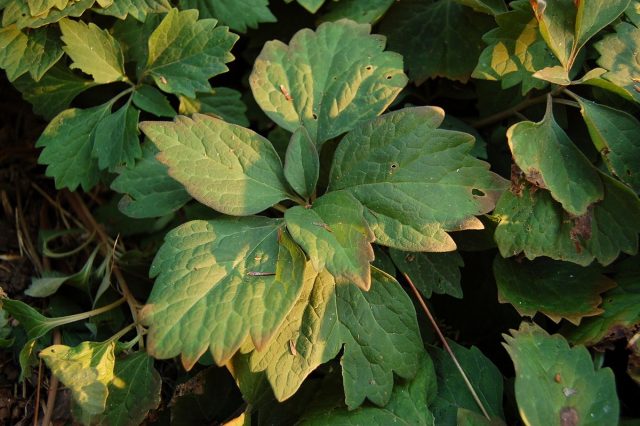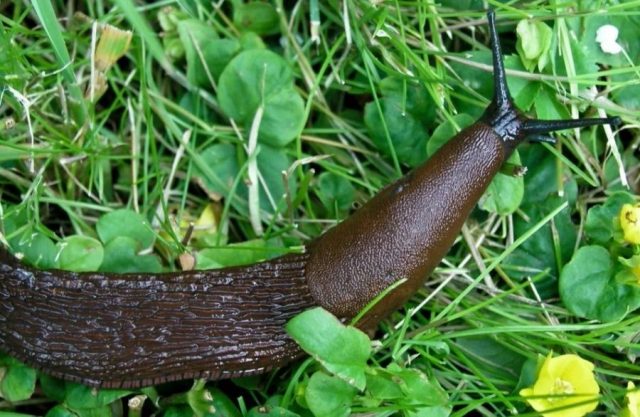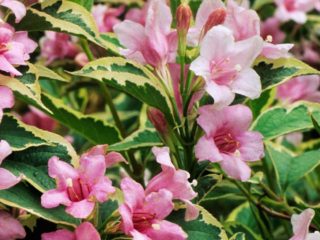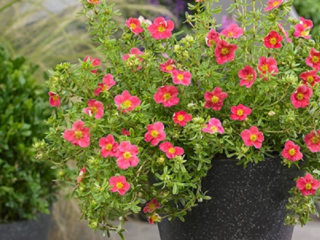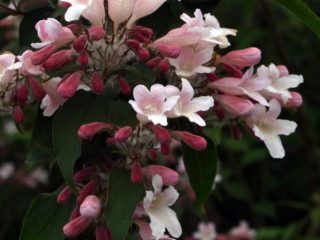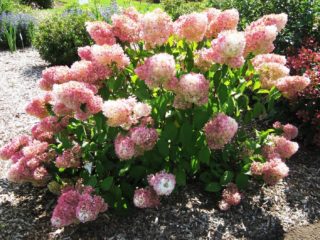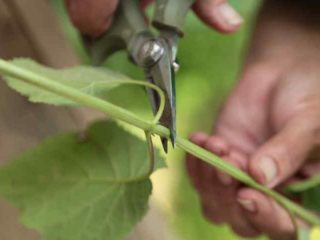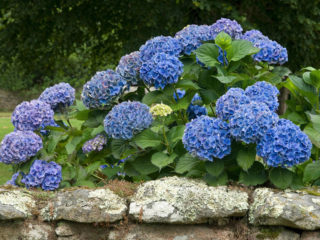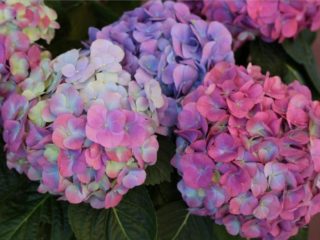Content
Photos and descriptions of pachysandra allow you to get an idea of the ornamental hardy shrub. Before planting a plant on a site, you need to study its basic requirements.
Description of pachysandra shrub with photo
Pachysandra is a perennial plant of the Boxwood family. It has a very powerful superficial root system, spreading widely to the sides, and straight, strong stems. The leaves of the plant are oval or ovate, up to 6 cm in length, bright green and glossy, with a serrated edge. The plates are located on the stem on short petioles and are replaced every three years.
In its natural form, pachysandra is widespread throughout Asia; it can be found in Japan and China. The subshrub also grows in temperate climates in North America.
Is pachysandra poisonous?
Like many plants from the Boxwood family, pachysandra is poisonous. Therefore, it must be bred with caution, especially if there are children and pets on the site.
Winter hardiness of pachysandra
The frost resistance indicators of the subshrub are not the highest. Typically, the plant can withstand temperatures as low as -15 °C. For this reason, the crop is more often grown in warm climates than in the middle zone and cold regions.
Pachysandra height
The straight stems of pachysandra rise only 35 cm above the ground. In landscape design, the plant is usually used as a ground cover.
Pachysandra flowering
Flowering of pachysandra usually begins in mid-May. At the tops of the plant stems, small cream or greenish-white spikelets up to 5 cm long appear, formed by male and female buds. The inflorescences look discreet, but emit a pleasant, delicate aroma. The period of decorative culture lasts about a month.
A few years after planting, the subshrub bears small white berries. Each fruit contains one small seed.
Types and varieties of pachysandra
A mature pachysandra plant looks different depending on the variety. There are several of the most popular varieties of culture.
Pachysandra apex (Japanese)
Apical pachysandra (Pachysandra terminalis) is a shrub with lodging stems up to 35 cm in length. It has a long, spreading rhizome and forms dense thickets in the area. The leaves of the plant are dense, ovoid, dark green in color. The flowers of the subshrub are greenish and appear from April to May.The plant can bear fruit in the southern regions, but in the middle zone it usually does not form seeds.
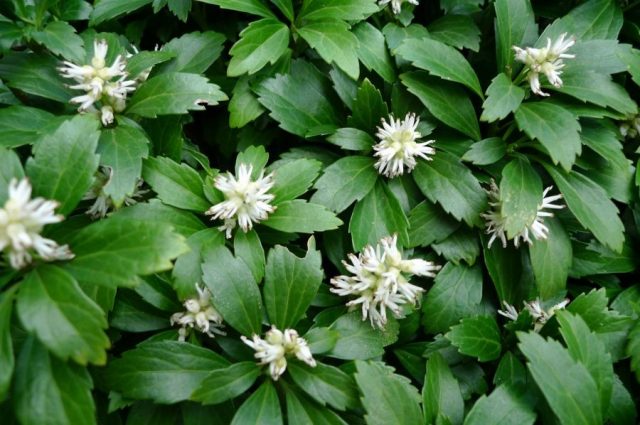
Apical pachysandra is characterized by increased frost resistance and can withstand cold temperatures down to -29 ° C
Pachysandra terrestris
Creeping pachysandra (Pachysandra procumbens) is an evergreen plant that occurs naturally in North America. It has rigid, straight and thin lodging stems. The leaves are oval, pointed at the top and serrated at the edges. In spring, the plates have a beautiful purple hue with silver specks; in summer they become bright green. The flowers of the variety are white, collected in loose spikelets.
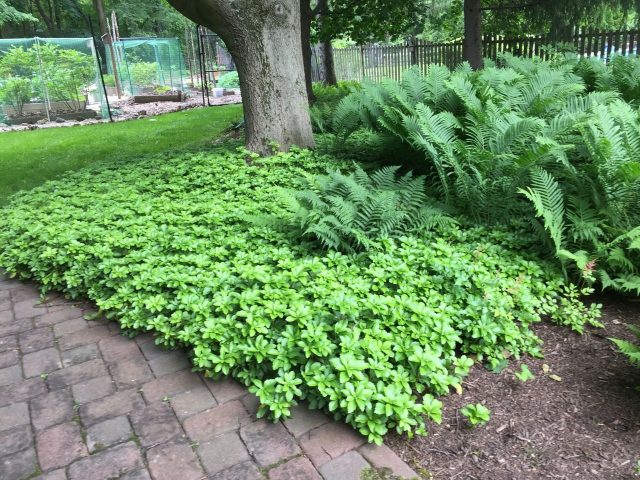
Creeping pachysandra reaches a height of no more than 30 cm
Axillary
Axillary pachysandra (Pachysandra axillaris) is a fairly tall variety, up to 45 cm above the ground. It is distinguished by the presence of white pubescence on the stems and plates; the leaves are oval, bright green, up to 10 cm in length. Blooms with discreet white buds collected in axillary inflorescences.
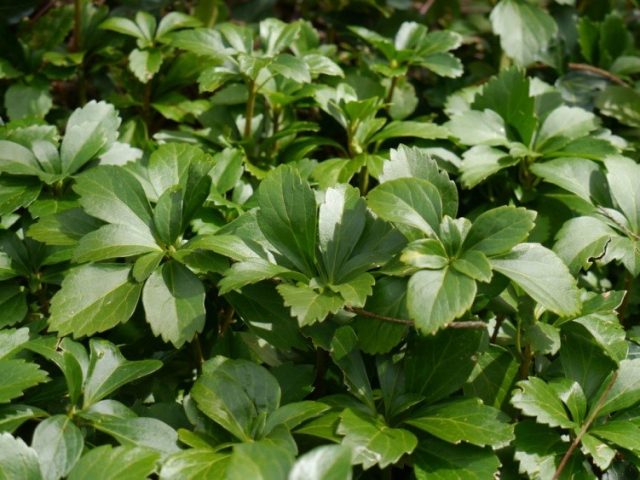
In its natural form, axillary pachysandra is widely distributed in China.
Prostrate (lying down)
Prostrate pachysandra (Pachysandra procumbens) is a low variety up to 30 cm above the ground. It has reddish-brown stems and light green leaves with dark spots. The photo of a pachysandra flower shows that the plant blooms with white or pinkish buds, collected in spikelets up to 12 cm.
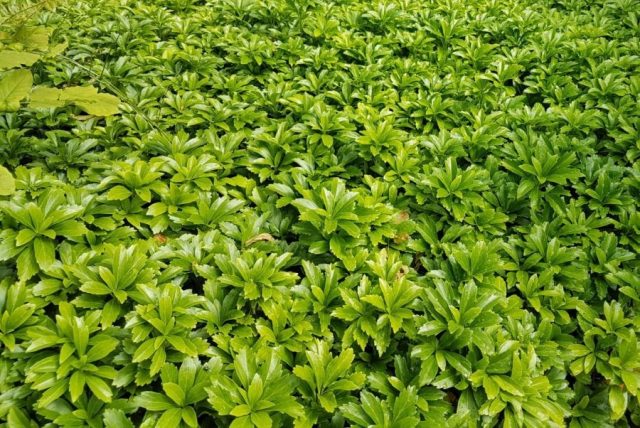
Of all the species, prostrate pachysandra is the only one that sheds its leaves every year.
How to plant pachysandra
To grow a crop on the site, first of all, you need to choose the right planting site for pachysandra. The plant is placed in shade or partial shade, since the shrub does not like direct sunlight.The soil needs to be moist and fertile, with a neutral or slightly acidic composition. The culture can develop without problems on clay soil, but it is better not to place it on sandy loam.
Planting is carried out in the spring in April or in the fall until the end of September. The procedure is prescribed on a warm and dry day. It is not recommended to plant the semi-shrub in the ground in early spring or just before frost in the fall. In cold soil, the plant will take root slowly and is likely to die.
Before planting a subshrub, the area needs to be prepared. The chosen place is properly dug up and cleared of weeds, the soil is fertilized with compost and watered abundantly. It is allowed to add mineral preparations to the soil, with preference given to potassium and phosphorus mixtures. The site is prepared approximately a week before the seedling is transferred to the soil.
The immediate planting scheme looks like this:
- A hole is dug at the site with a depth of about 40 cm.
- Place a drainage layer of gravel or pebbles on the bottom of the hole.
- Fill the hole halfway with soil with the addition of sand and humus.
- Place the seedling in the center and fill the remaining voids with substrate.
- Lightly compact the soil.
- Water thoroughly and mulch the soil.
If you are planting several bushes at once, you need to place them at intervals of 25 cm and in quantities of no more than 4-7 per 1 m2. Otherwise, the plants will gradually intertwine their roots and begin to interfere with each other during development.
Caring for pachysandra in open ground
Caring for evergreen pachysandra is usually not difficult. When growing a subshrub, you need to pay attention to several points:
- Watering. Pachysandra loves moist soil, but when caring for it, you need to take into account that the crop is usually planted in the shade. Therefore, the plant does not require frequent watering - the soil dries out quite slowly. It is necessary to add moisture only during severe, prolonged drought.
- Feeding. On fertile soil rich in humus, pachysandra can grow without fertilizers. If the soil is poor, the semi-shrub can be watered from time to time with complex mineral compounds. At the same time, it is important not to apply fertilizers too often - this will negatively affect the decorativeness of the crop.
- Trimming. From time to time the plant needs to be pinched at the top. Old shoots gradually stretch out, so there are fewer leaves, and the subshrub stops bushing. After pinching, the splendor returns and new plates appear. The procedure is performed as needed; pachysandra should be pruned in early autumn or spring before flowering.
Before the onset of winter cold, the decorative subshrub should be carefully mulched with dry leaves and insulated with spruce branches. After snow falls, it is recommended to form a snowdrift over the plant. For pachysandra in winter, severe frosts with little precipitation pose a particular danger; in this case, the roots of the subshrub may freeze.
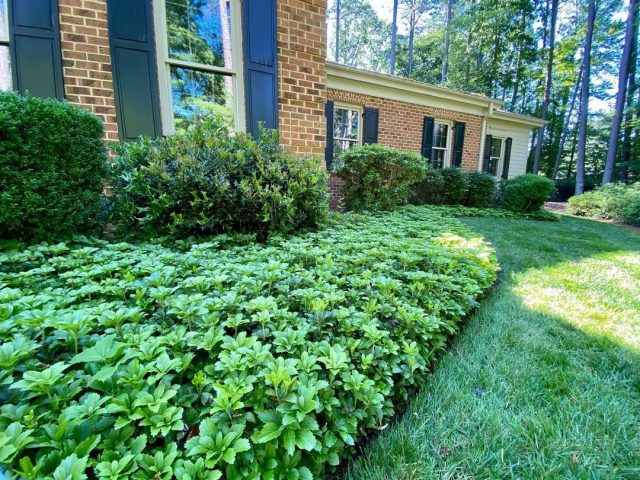
Typically, pachysandra does not require loosening, since it forms a dense turf above the soil surface
Diseases and pests
Pachysandra has good immunity and usually successfully resists fungi and insects. But some diseases and parasites still pose a danger to her.Namely:
- late blight - brownish marks appear on the leaves of the crop, over time the spots fall out and leave behind holes;
Late blight affects pachysandra during chronic waterlogging
- slugs - gastropods attack the plant in damp, cool weather and eat young greenery.
To protect against slugs, it is recommended to sprinkle the soil at the roots with wood ash.
To prevent diseases, it is necessary to first control the degree of soil moisture. The soil in the area with the plant should be slightly damp, but not swampy. At the first signs of fungi, pachysandra is treated with copper preparations or Fitosporin, all affected shoots are cut off and destroyed.
How does pachysandra reproduce?
Several methods are used to propagate subshrubs on a site. Vegetative methods are usually used, but if desired, the crop can also be grown from seeds.
Cuttings
Pachysandra is propagated by cuttings at the beginning of the growing season. In spring, several lateral or apical shoots are cut off from an adult plant. The lower part of the cuttings is treated with Kornevin or Epin, and then the sprouts are placed in loose, moist soil. Rooting occurs quickly; already in the fall, the young subshrub can be transferred to a permanent place.
Seeds
Propagation of apical pachysandra by seeds is not often done, since adult plants do not provide planting material in all regions. The crop cultivation scheme looks like this:
- Seeds are sown in open ground immediately after autumn harvest.
- The beds are immediately insulated for the winter with dry leaves and spruce branches.
- In spring, the cover is removed and the sprouts are provided with moderate watering.
Seeds need to be sown with a reserve, since their germination rate is low.During the first three years, the subshrub will form a root system and only then will it begin to actively grow green mass. The first flowering can only be expected for 3-5 years.
Dividing the bush
An adult, overgrown subshrub on a site can be divided by its rhizome. At the beginning of May, the plant is carefully dug out of the ground and cut into several parts so that each seedling has a renewal bud. The resulting divisions are immediately planted in shallow holes at a distance of about 20 cm from each other and watered properly.
Using pachysandra in the garden
The culture cannot boast of bright flowering, but it is often used in landscape design due to its dense, bright greenery. The plant is usually planted in shaded areas, in vacant lots or in tree trunks. Using a semi-shrub you can form a low border or a miniature hedge.
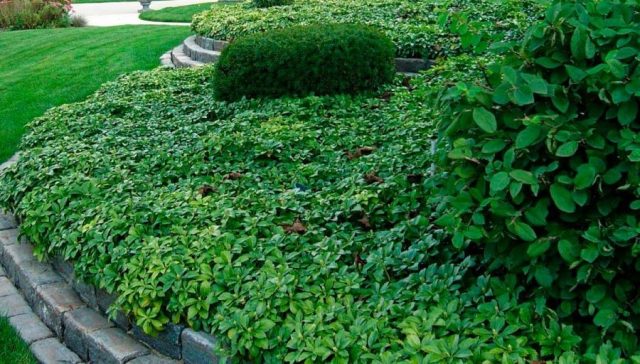
If you plant pachysandra on a slope, it will help prevent soil collapse
The culture looks impressive against the backdrop of wooden facades, brick buildings and bright perennial flowers. Good neighbors for her are lobelia and periwinkle, sedum and loosestrife. You can also plant the semi-shrub next to kupena, aquilegia and dicentra.
Conclusion
Photos and descriptions of pachysandra represent a hardy and unpretentious, but very beautiful ground cover crop. Most plant species are evergreen, look impressive in any area and require almost no feeding.
